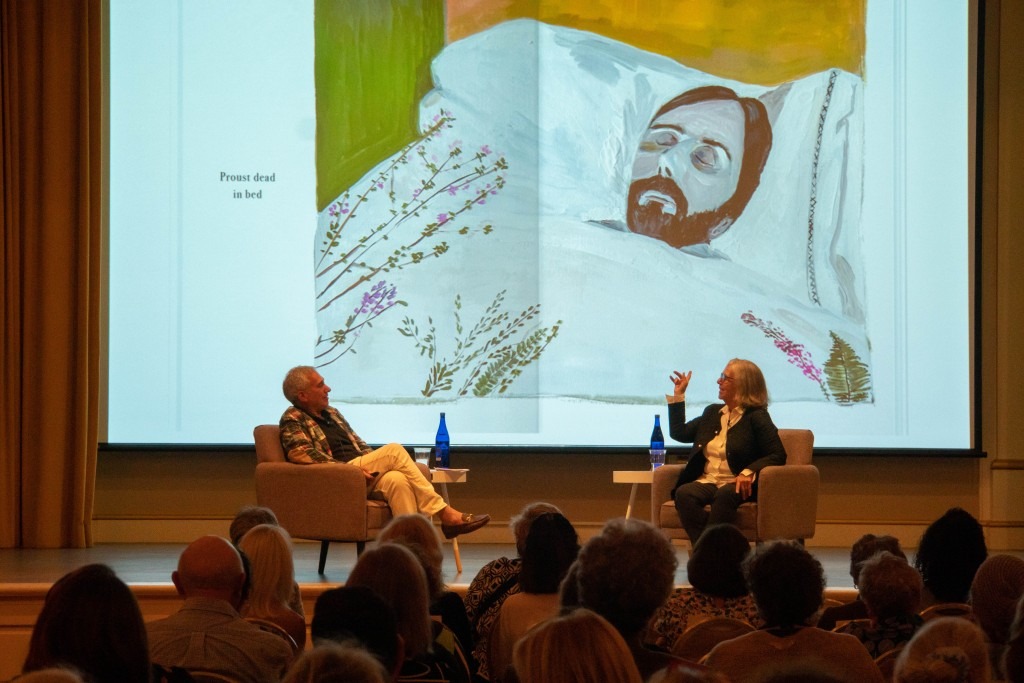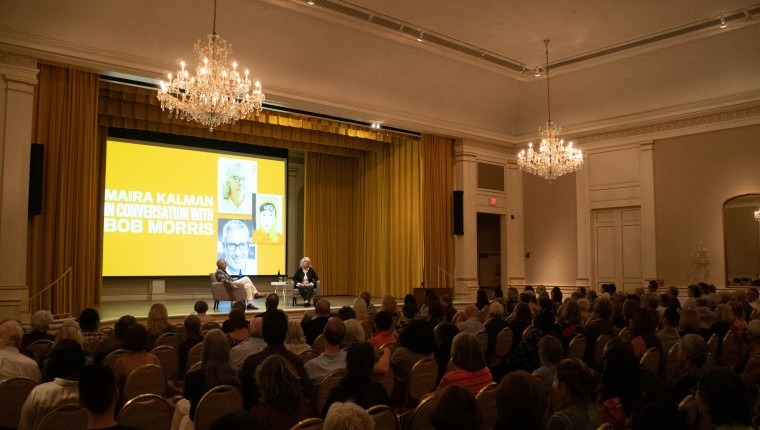Story and Photos by Jennifer Ring
. . .
The Museum of Fine Arts
Brings a Series of Cultural Luminaries
to St. Pete this Spring
. . .
Through May 4
Museum of Fine Arts
Details here
. . .
Feeling uninspired? Consider visiting the Museum of Fine Arts in downtown St. Pete. That’s what I did when the MFA hosted Maira Kalman in Conversation with Bob Morris.
Kalman and Morris’s February 9 conversation launched an exciting slate of winter-spring programming at the MFA that includes visits from former U.S. Poet Laureate Billy Collins (March 23), international museum architect Florian Idenburg (March 26) and influential art critic Jerry Saltz (April 1).
It’s designed to make you think, feel and discuss. And if Kalman and Morris’s conversation is any indication of what’s to come, it’s going to be awesome.
I drove to the MFA that day seeking inspiration from one of today’s most successful storytellers, and I found it.

Maira Kalman’s written and illustrated more than 30 books in her decades-spanning career. The list includes The Autobiography of Alice B. Toklas and the classic writing manual, The Elements of Style, by William Strunk Jr. and E.B. White. Her latest book, Women Holding Things, holds a coveted spot on the New York Times’ list of 2022’s best art books. So, naturally, the MFA’s Marly Room was packed when Kalman came to town.
In Women Holding Things, Kalman shows us how the things we hold define who we are as human beings.
The women in Kalman’s book are family members, notable people like Gertrude Stein and Virginia Woolf, and total strangers. They hold on to garden shears, cooking utensils, opinions, traditions and more. Each of these women captivated Kalman in some way, and she ran with it. It’s kind of what she does.
“When something captivates you, that’s a subject,” Kalman said to the crowd assembled at the MFA.
. . .
She still remembers the exact moment when the idea for Women Holding Things came to her.
“We went to the farmer’s market, and there was a woman there holding two dogs and a giant cabbage, and it was so beautiful,” says Kalman. “I asked the woman if I could take her photograph — she was so irritated, and I loved that she was irritated.” Kalman named the resultant painting irritated woman holding giant cabbage.
It’s impossible to flip through the pages of Kalman’s Women Holding Things without thinking of the things you yourself hold and what these things say about your life. And then you wonder, “What do my family members hold and what do these things mean to them? What about my friends? The person sitting next to me?” This is where the conversations begin.
If the things we hold shape our identities, then what happens when we are stripped of these things? Kalman poses this question with an illustration of E. F. Benson’s garden room. Or rather what’s left of E.F. Benson’s garden room after the Nazis bombed it.
Shortly after, Kalman shares a painted portrait of her mother’s family taken in 1931. “They also loved holding things before half of them perished in Auschwitz,” she writes.
. . .
Although Kalman’s book is full of fun, whimsical images, it takes a turn about halfway through. Many of the things we hold in life — like loved ones, party favors and hobbies — are a gift, not a burden. But for all these things, there are more things. Things that are difficult to hold on to. Things that perhaps we shouldn’t hold on to, like a grudge, a gun or a failed marriage.
The conversation went beyond Women Holding Things, delving into Kalman’s earlier works to reveal the common thread connecting her various projects.
The list of people and things that captivate Kalman might not make sense to many people.
Like, why Alice B. Toklas? And what’s so interesting about a random stranger carrying a gigantic cabbage?
Most people wouldn’t notice these things, but Kalman’s made a living seeing things that others don’t. But her success goes beyond that. It’s not enough to just observe.
Kalman’s projects start with an idea, like, “What if I dressed up as Gertrude Stein’s partner, Alice B. Toklas, and ordered a hot dog from a New York City street vendor?” It sounds like the kind of idea I would come up with over one too many cocktails with friends. I would have dismissed the idea as not marketable, too silly and too much work by the next day.
But Kalman followed through on it, creating the hilarious short film My Name is Alice B. Toklas which she shared at the end of her conversation with Morris.
. . .
Watching Kalman order a hotdog and dance down the street dressed like Alice B. Toklas reminds me what it means to be a courageous creative.
I left Kalman and Morris’s In Conversation with three key takeaways.
. . .
- Allow yourself to be captivated.
- Spend time with the things and the people who inspire you.
- Follow through on your crazy ideas.
. . .
Before I left the MFA, I walked up to Kalman at the table where she was signing books, handed her a copy of her illustrated The Elements of Style, and asked her a single question –
“So, were you so captivated by Strunk and White that you just called Penguin and asked if you could illustrate it?”
“Yes,” she said, without hesitation. “It took a couple of years, but yes. I don’t give up.”
. . .
. . .



